The combination of high elevation and a semi-arid climate makes the Colorado Plateau particularly vulnerable to climate change. Climate models predict that over the next 100 years, the Southwest will become warmer and even more arid, with more extreme droughts than the region has experienced in the recent past.
Climate Change Impacts on the Colorado Plateau
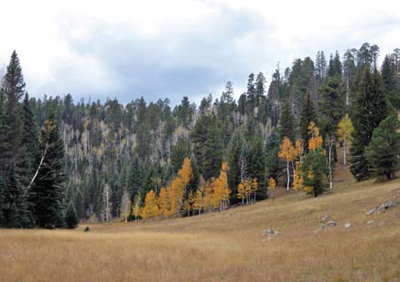
These changes will affect both the montane and lower-elevation ecosystems. Because mountain plant species have narrow habitat tolerances and only marginal habitats are available for some species, climate change is likely to result in higher rates of species loss at higher elevations than at lower elevations. At lower elevations, the slow-growing vegetation of semi-arid grasslands, shrublands, and woodlands may not be as resilient as more productive ecosystems to climate-related disturbance, such as severe droughts and increased fire frequency.
Vegetation and Soils
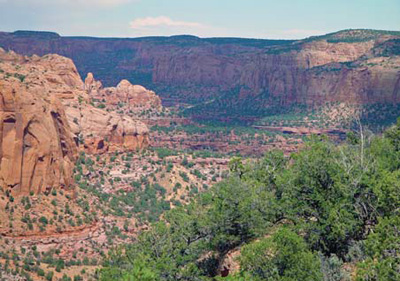
A warmer and more arid climate has the potential to affect vegetation by altering the relative dominance of species, shifting the elevational distribution of some species, and decreasing overall vegetative cover. Decreases in vegetative cover may increase soil erosion, which can cause further dramatic changes in vegetation structure and com position. Climate change can also result in altered fire regimes and increased vulnerability to exotic species invasion. Drought-induced pinyon pine (Pinus edulis) die-off has recently been documented across the Southwest, with 90% mortality recorded in high-elevation sites near Bandelier National Monument and Mesa Verde National Park. The Southern Colorado Plateau Network of the NPS Inventory and Monitoring Program is monitoring vegetation and soils, which are reliable indicators of upland ecosystem integrity. To date, the network has established 148 monitoring plots in 12 ecosystems in 9 parks, and has plans to expand monitoring to additional ecosystems and parks.
Vegetation Phenology
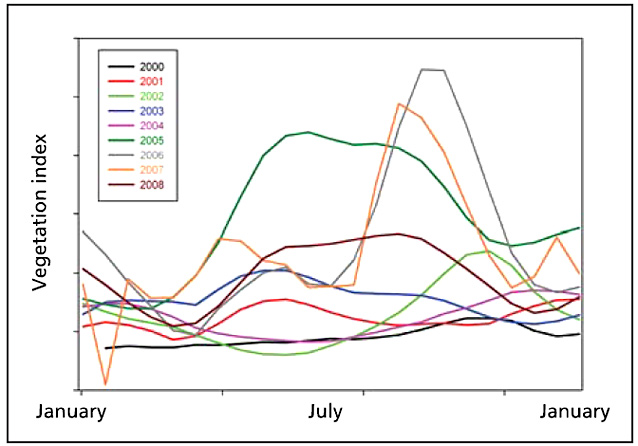
Growing seasons are expected to lengthen as a result of climate change and this can have complex ecological consequences. In the American Southwest, increases in temperature may result in a prolonged dry period between the winter months and the onset of the summer monsoon. The Southern Colorado Plateau Network is using Moderate Resolution Spectraradiometer (MODIS) satellite data to monitor growing season patterns and trends for major vegetation types occurring in our parks. These data provide us with a measure of vegetation growth at 16-day intervals throughout the year, enabling us to track the onset, duration, and magnitude of the growing season for the major vegetation types.
Aquatic Macroinvertebrates
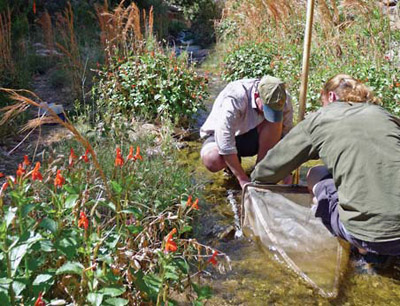
Climate change is predicted to have multiple effects on aquatic ecosystems, such as the disruption of natural flood regimes, alteration of natural temperature cycles, and increased risk for invasion and persistence of nonnative aquatic organisms. All are likely to have profound consequences for aquatic communities. Aquatic macroinvertebrates are an essential component of healthy aquatic ecosystems and are sensitive to environmental changes. The Southern Colorado Plateau Network monitors aquatic macroinverterbrate populations in streams to monitor the overall health of stream ecosystems in its parks. The data enable network staff us to observe changes in macroinvertebrate community structure and function and in abiotic stream components, such as water quality and habitat availability.
Spring Ecosystems
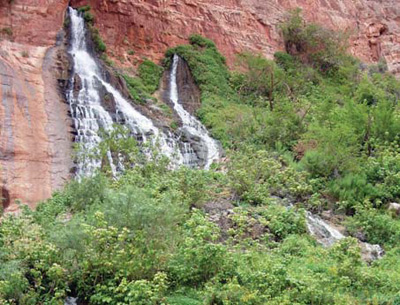
Springs are the most productive and biologically diverse ecosystems in the arid Southwest, and, in some areas serve as the only reliable water source for wildlife. Climate change could lead to changes in the amount, timing, and distribution of rain and snowfall, potentially affecting aquifer recharge rates, diminishing spring flow, and causing changes in the composition and structure of aquatic and riparian plant and animal communities. On the Colorado Plateau, springs provide vital habitat for both endemic and regionally rare species, including several types of orchids and the declining populations of leopard frogs. The Southern Colorado Plateau Network plans to monitor the hydrology and biologic communities at springs in network parks.
Riparian Ecosystems
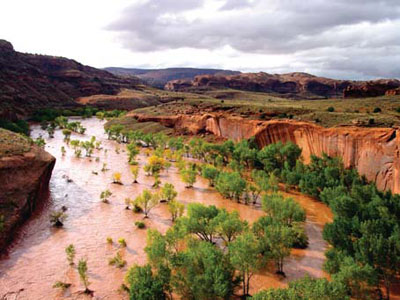
© Stefanos Folias
Many streams and rivers in Southern Colorado Plateau Network parks are intermittent or ephemeral, flowing only during spring runoff or following monsoon rainfall events. On the Colorado Plateau, the precipitation regime is the most important climatic factor influencing the characteristics of riparian ecosystems—shaping stream channels and supporting water-limited ecological processes, such as primary production, nutrient cycling, and plant reproduction. The timing (seasonality) of precipitation and runoff is particularly important because it strongly controls the hydrologic regime—evaporation, transpiration, runoff, soil-water storage, and streamflow. The Southern Colorado Plateau Network monitors the hydrology, riparian vegetation, and fluvial geomorphology of streams and rivers in network parks.
Contact Information
Christopher Calvo, Southern Colorado Plateau I&M Network, Science Communicator; Christopher_Calvo@nps.gov
Prepared by the Southern Colorado Plateau Network I&M Program.
Tags
- aztec ruins national monument
- bandelier national monument
- canyon de chelly national monument
- chaco culture national historical park
- el malpais national monument
- el morro national monument
- glen canyon national recreation area
- grand canyon national park
- hubbell trading post national historic site
- mesa verde national park
- navajo national monument
- petrified forest national park
- petroglyph national monument
- rainbow bridge national monument
- salinas pueblo missions national monument
- sunset crater volcano national monument
- walnut canyon national monument
- wupatki national monument
- yucca house national monument
- swscience
- climate change
- scpn
- southern colorado plateau
- science
- project
- riparian habitat
- springs
- aquatic macroinvertebrates
- soils
- phenology
- freshwater invertebrates
- hydrology
- climate change effects
- jmrlc
- natural resources
Last updated: January 12, 2023
